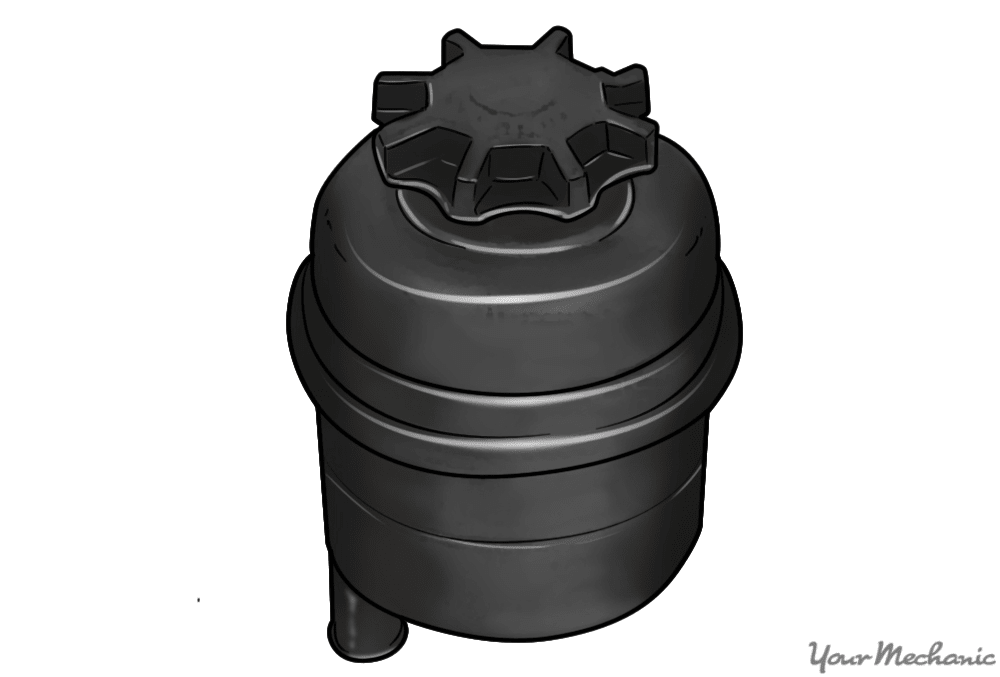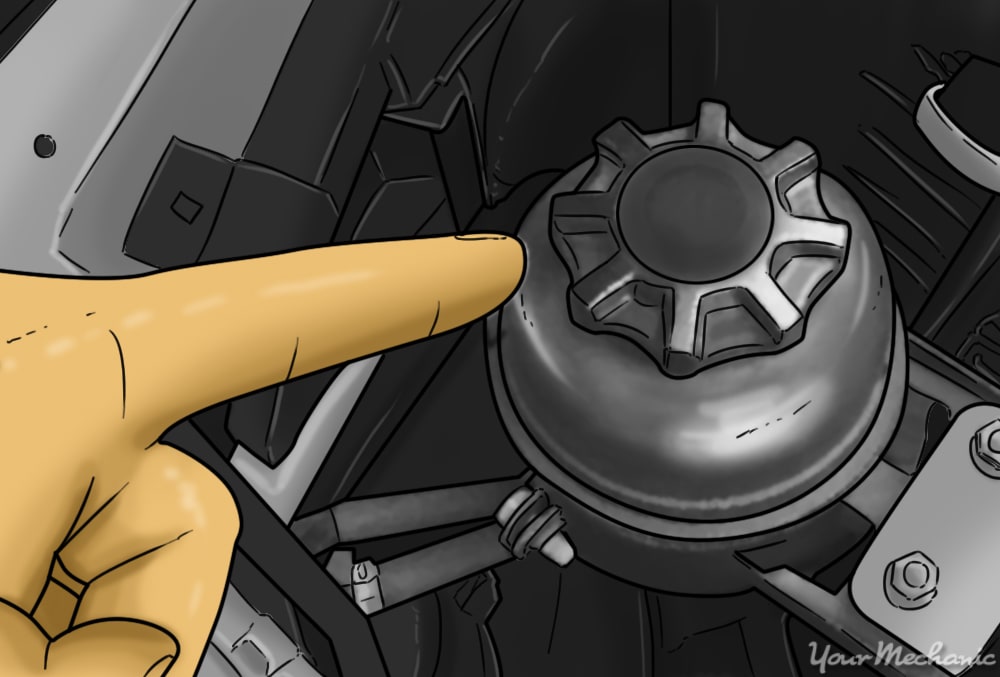

The power steering fluid reservoir has been an important part of vehicles since the debut of the power steering system in 1951. Most vehicles on the road today utilize a hybrid style power steering system, where the traditional hydraulic power steering system is assisted by electronic servos attached to the steering column. However, unless your vehicle’s steering is 100% electronically controlled, it's likely that you have a power steering fluid reservoir that is used to contain excess power steering fluid so that your power steering system works efficiently.
When the power steering fluid reservoir is broken or leaking, the power steering fluid reservoir will display a few common symptoms indicating that the part needs to be replaced. Some of these warning signs include the smell of power steering fluid burning, a whining noise while turning, power steering fluid leaking from under the vehicle, or the vehicle becoming hard to steer.
Part 1 of 1: Replacing the power steering fluid reservoir
Materials Needed
- Boxed end wrench or ratchet wrench
- Flashlight
- Hydraulic line wrenches
- Large flat blade screwdriver
- Liquid containment drain pan
- Replacement hose clamps
- Replacement power steering fluid hoses (if needed)
- Replacement power steering fluid reservoir
- Safety equipment (safety glasses & gloves)
- Side cutters
- Vice grips
Step 1: Disconnect the vehicle's battery. Before removing any parts, locate the vehicle's battery and disconnect the positive and negative battery cables.
- Note: This step should always be the first thing you do when you work on any vehicle.
Step 2: Remove any covers or lines in the way of the power steering fluid reservoir. On some cars, there may be an engine cover or air filter hose that covers the power steering fluid reservoir.
Refer to your service manual for exact instructions on removing these components before attempting to remove the power steering fluid reservoir.
Step 3: Place shop rags under all power steering fluid lines connected to the reservoir. This part will leak when you remove it, so it's a good idea to place a good supply of shop rags underneath all the lines that need to be removed to avoid hydraulic fluid leaking onto other parts.
Step 4: Inspect the power steering fluid reservoir for cracks or damaged lines/connections. Sometimes the leaking will be caused by a power steering hose that is connected to the fluid reservoir. Check this before you remove the reservoir.
If the leak is coming from a particular connection, replace that entire hose as well as the reservoir.
Step 5: Remove the hose clamp from the return hose. On many vehicles, the power steering return line will be connected to the power steering fluid reservoir near the top of the fill neck. Locate this connection and remove the hose clamp.
If the hose clamp is a screw-type hose clamp, use the right type of screwdriver to loosen the clamp and slide it back for reuse. If the clamp is a clip style, cut it off and replace it with a new hose clamp.
When the return hose has been removed from the reservoir, place it behind the fuel line or other hoses pointing upward to avoid leaking. You'll be reattaching this hose soon, so just keep it out of the way for now.
Step 6: Remove the reservoir from the coolant bottle or attachments. If your power steering fluid reservoir is attached to the washer fluid reservoir as the image indicates, press the tab and clip that secures the tanks together and pry the reservoir upward using a long, flat screwdriver.
If the fluid reservoir is attached to a bracket or the firewall, remove the bolts holding the unit on.
Once the reservoir has been removed, let it sit inside the engine compartment. You'll remove it after the next few steps.
Step 7: Close off the bottom power steering hose with vice grips. The bottom of the power steering fluid reservoir will be attached to a hose that runs to the power steering pump. Using a pair of vice grips or other clamps, shut off the supply of fluid near the top of the hose, as close to the reservoir as possible.
This will ensure excess fluid does not drain as you remove this hose.
Step 8: Remove the supply hose from the reservoir. Once this hose has been pinched, remove it by removing the clamps and prying it off the male attachment.
Make sure to use some shop rags to plug the hole from the fluid reservoir so it doesn't leak.
Step 9: Remove the power steering fluid reservoir. While holding one finger on the supply line fitting where you just removed the hose to avoid leaking, carefully remove the power steering fluid reservoir and place it inside a fluid containment device.
Allow the excess power steering fluid to fully drain, then recycle the power steering fluid correctly.
Step 10: Install a new hose clamp onto the supply hose. Before you install the new fluid reservoir, it's a good idea to prep the two lines. There is one attached to the bottom of the fluid reservoir, and another attached to the top (the return line).
Make sure to use the manufacturer’s recommended hose clamps and install them on the lines for easy installation as you proceed to install the new unit.
Step 11: Install the new fluid reservoir. After you've removed the old one and prepped the hoses for installation, the install of the new fluid reservoir is in exact opposite order from the removal.
Attach the bottom supply line to the bottom of the power steering fluid reservoir, then attach the top return line to the top fitting on the new power steering fluid reservoir.
Reattach the fluid reservoir to its housing, bracket or the firewall. Double check all hoses and fittings on the power steering fluid reservoir to ensure that they are secure and tight.
Fill the new reservoir with new power steering fluid. Reconnect the battery cables.
Step 12: Prime the power steering fluid system. Always refer to your vehicle’s service manual for exact instructions on how this is supposed to be completed.
In general, you’ll first start your vehicle with the power steering fluid reservoir cap closed.
Let it run for about two minutes, then shut off the vehicle and check the fluid level inside the reservoir.
Top off the fluid and restart the vehicle.
Step 13: Test drive the vehicle. It's recommended to take the vehicle on a 10 to 15 minute road test to ensure the steering system works correctly on different road conditions.
If you've read these instructions and still don't feel 100% confident in completing this repair, please contact one of the local ASE certified mechanics from YourMechanic to complete the power steering fluid reservoir replacement for you.








